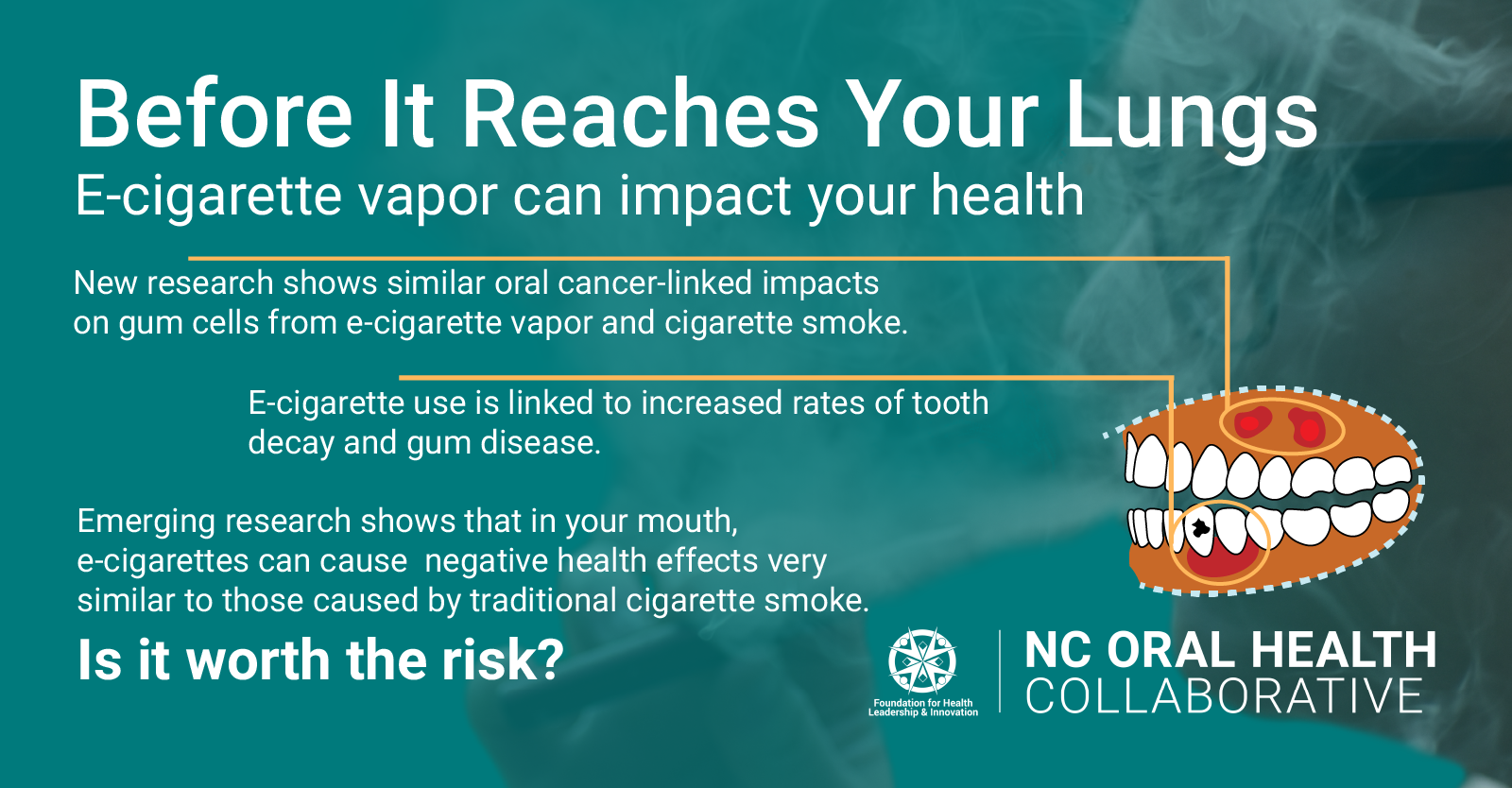With youth-oriented advertising depicting e-cigarettes as not only a cigarette alternative, but a clean, fun, and popular choice to make, an increasing number of teens and young adults are picking up the habit, often without having ever smoked cigarettes in the first place.

The quick adoption of e-cigarettes among young users is especially alarming because experts still don’t know what long-term health outcomes may result. Because of that, no one can say for sure what will happen to young people who habitually smoke e-cigarettes, even though initial research suggests that many negative health impacts are possible.
April is Oral Cancer Awareness Month, so we’re taking a look at e-cigarettes and what existing research suggests about their impact on the mouths and throats of users.
Here are some of the health outcomes discovered so far.
Gum Inflammation
A study in Oncotarget, a peer-reviewed oncology and cancer research journal, found that flavored e-cigarettes induce gum inflammation. The study found that e-cigarette use causes a form of DNA damage that re-enforces chronic inflammation, an important contributor to the spread of oral disease.
Bone Loss, Oral Disease, and Tooth Decay
Several studies (cited below) have found connections between e-cigarette use and bone loss, oral disease, and tooth decay.
One study of 18,289 participants found that those with no history of gum disease who used e-cigarettes regularly for one year had increased odds of being diagnosed with gum disease.
Another study of 456,343 adults found an independent association—meaning the association persisted even when other risk factors were controlled—between e-cigarette use and the likelihood of having at least one permanent tooth removed because of tooth decay.
Sources
- Association between regular electronic nicotine product use and self-reported periodontal disease status
- Association of e-cigarette use with oral health – a population-based cross-sectional questionnaire study
- E-cigarette vapor induces an apoptotic response in human gingival epithelial cells through the caspase-3 pathway1
- Effect of electronic cigarette usage on oral health: a six-month prospective study
- Electronic cigarettes and oral health: a narrative review
- Influence of electronic cigarettes on selected antibacterial properties of saliva
- Oral health of smokersand e-cigarette users: a case-control study
Oral Cancer
A study in the International Journal of Molecular Science compared e-cigarettes and traditional cigarettes, focusing on their impacts on the mouth at a cellular level. Broadly, this study found similarities between cigarettes and e-cigarettes when it comes to the cellular damage that has the potential to lead to oral cancer.
Additionally, other studies cited below found potent carcinogens and carcinogenic trace metals in e-cigarette vapor and the saliva of e-cigarette users.
Sources
- Deregulation of biologically significant genes and associated molecular pathways in the oral epithelium of electronic cigarette users
- Health effects of trace metals in electronic cigarette aerosols – a systematic review
- Presence of the carcinogen N’-nitrosonornicotine in saliva of e-cigarette users
What does all this mean?
What do we know E-cigarettes have been associated with poor oral health outcomes, from tooth decay and gum disease, to a potentially increased risk of oral cancer.
What don’t we know Without further research, oral health care experts cannot say how often poor outcomes will happen, how often an individual must use an e-cigarette to be impacted by negative health outcomes, or how severe the impacts could be.
Long-term studies must be conducted in order to obtain more representative data.
However, what we do know is important: The risk is present, and e-cigarette users must ask themselves,
“Is it worth the risk?”
NCOHC is a program of the Foundation for Health Leadership & Innovation. For more information and to stay up to date, subscribe to the NCOHC newsletter. If you are interested in becoming an NCOHC member, you can also fill out our membership form. It’s free!


 العربية
العربية 简体中文
简体中文 English
English Filipino
Filipino Français
Français Deutsch
Deutsch हिन्दी
हिन्दी Hmong
Hmong 한국어
한국어 Русский
Русский Español
Español தமிழ்
தமிழ் తెలుగు
తెలుగు Українська
Українська Tiếng Việt
Tiếng Việt